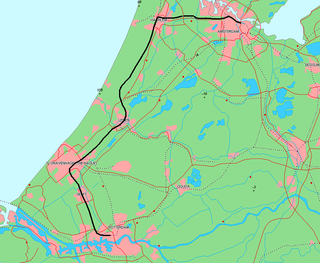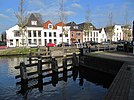
Utrecht, officially the Province of Utrecht, is a province of the Netherlands. It is located in the centre of the country, bordering the Eemmeer in the north-east, the province of Gelderland in the east and south-east, the province of South Holland in the west and south-west and the province of North Holland in the north-west and north. The province of Utrecht has a population of about 1,388,000 as of January 2023. With a land area of approximately 1,484 square kilometres (573 sq mi), it is the second smallest province in the country. Apart from its eponymous capital, major cities and towns in the province are Amersfoort, Houten, IJsselstein, Nieuwegein, Veenendaal and Zeist. The busiest railway station in the Netherlands, Utrecht Centraal, is located in the province of Utrecht.

Amersfoort is a city and municipality in the province of Utrecht, Netherlands. As of 31 January 2023, the municipality had a population of 160,902, making it the second-largest of the province and fifteenth-largest of the country. Amersfoort is also one of the largest Dutch railway junctions with its three stations—Amersfoort Centraal, Schothorst and Vathorst—due to its location on two of the Netherlands' main east to west and north to south railway lines. The city was used during the 1928 Summer Olympics as a venue for the modern pentathlon events. Amersfoort marked its 750th anniversary as a city in 2009.

Aalsmeer is a municipality and a town in the Netherlands, in the province of North Holland. Its name is derived from the Dutch for eel (aal) and lake (meer). Aalsmeer is bordered by the Westeinderplassen lake, the largest open water of the Randstad, and the Ringvaart Canal. The town is located 13 km (8 mi) southwest of Amsterdam.

Amsterdam Zuid is a railway station situated in the borough of Amsterdam-Zuid in Amsterdam, Netherlands. For a number of years, it was named Amsterdam Zuid WTC, in reference to the neighbouring World Trade Center Amsterdam. During 2006, in conjunction with the rapid development of the area surrounding the station, the station was enlarged and the reference to the WTC was formally dropped from the name.

Weespstation is a railway station in Weesp, Netherlands. The station has two island platforms and a total of six tracks, two of which are used for passing trains. The Schiphollijn, Flevolijn and Gooilijn meet at Weesp making it an important transfer station for passengers going between Amsterdam, Hilversum and Almere. The first station in Weesp opened on 10 June 1874, when the Gooilijn from Amsterdam to Hilversum and Amersfoort was completed. The original station was demolished in 1967 and replaced by a new building. The new building partially went out of service in 1985 because of the new railway line from Weesp to Almere and beyond, called the Flevolijn. The out-of-service part was later converted to a bicycle parking and repair shop. The remaining station is little more than a tunnel passing under the tracks, and a small coffee counter. Train services are operated by Nederlandse Spoorwegen.

Rail transport in the Netherlands uses a dense railway network which connects nearly all major towns and cities. There are more train stations than there are municipalities in the Netherlands. The network totals 3,223 route km (2,003 mi) on 6,830 kilometres (4,240 mi) of track; a line may run both ways, or two lines may run on major routes. Three-quarters of the lines have been electrified.

Amsterdam Bijlmer ArenA, previously named Amsterdam Bijlmer (1971–2006), is a railway station in the Bijlmermeer neighbourhood of stadsdeel (borough) Amsterdam-Zuidoost in Amsterdam, Netherlands. The station has five platforms and eight tracks; two for the Amsterdam Metro and six train tracks, along with a bus station. Train services are operated by Nederlandse Spoorwegen.

Hoofddorp is a railway station in Hoofddorp, Netherlands located on the Weesp–Leiden railway.

The Weesp–Leiden railway is a railway line in the Netherlands which runs between the cities of Weesp and Leiden; the line also passes through and serves Amsterdam Airport Schiphol.

Amsterdam Muiderpoort is a railway station in the east of Amsterdam. It was reopened on 15 October 1939 after being first opened in 1896. It is located 4 km southeast of Amsterdam Centraal. At this station the Amsterdam–Arnhem railway and the Amsterdam–Zutphen railway split, with the two parts of the station separated (keilbahnhof). The western part is the Amsterdam Centraal to Utrecht Centraal line. The eastern part is the Amsterdam Centraal to Amersfoort Centraal line. The station is operated by the Nederlandse Spoorwegen.

Diemen is the main railway station of the municipality of Diemen, Netherlands. It is located on the Amsterdam–Zutphen railway between Amsterdam Science Park and Weesp. The station was first opened in 1882 and then closed in 1929. It was reopened at the same location in 1974. The station building was completed in 1978. The train services are operated by Nederlandse Spoorwegen. Among the direct destinations are Almere, Amersfoort, Amsterdam Centraal, Hilversum, Lelystad, and Zwolle. There are connections to two bus services operated by GVB.

Diemen Zuid is a railway station is located in Diemen, a city to the southeast of Amsterdam. The railway station is served by Nederlandse Spoorwegen (NS) services as well as line 53 of the Amsterdam Metro.

Hilversum is a railway station in Hilversum, Netherlands. It is located approximately 28 kilometres (17 mi) southeast of Amsterdam. It located on the Amsterdam Centraal station – Amersfoort station part of the Amsterdam–Zutphen railway, with a branch to Utrecht Centraal station. There are two other stations in Hilversum: Hilversum Media Park to the north, and Hilversum Sportpark to the south.

The Amsterdam–Zutphen railway is a railway line in the Netherlands running from Amsterdam, North Holland to Zutphen, Gelderland via the province of Utrecht. It passes through the cities of Hilversum, Amersfoort and Apeldoorn. It is also informally called the Oosterspoorweg, with the part between Amsterdam and Amersfoort sometimes being called the Gooilijn because of the region it runs through.

The railway from Amsterdam through Haarlem to Rotterdam runs from Amsterdam Centraal to Rotterdam Centraal through Haarlem.

Maarssen is a railway station in Maarssenbroek and on the opposite side of the Amsterdam Rijnkanaal to Maarssen, Netherlands. The station opened on 18 December 1843 and is located on the Amsterdam–Arnhem railway. The services are operated by Nederlandse Spoorwegen.

The Amsterdam–Schiphol railway is an important 17 kilometre long railway line in the Netherlands that connects Amsterdam with Amsterdam Airport Schiphol, and allows trains to continue to Leiden, The Hague, and Rotterdam.

The Amsterdam–Arnhem railway, also referred to as the Amsterdam–Elten railway or Rhijnspoorweg in Dutch, is an important railway that connects Amsterdam in the Netherlands with Utrecht and Arnhem, and continues into Germany.

Intercity Direct, abbreviated to ICD, is a Dutch category of higher-speed train service, operating on the HSL-Zuid and connecting Amersfoort Vathorst / Lelystad to Amsterdam Zuid, Schiphol Airport, Rotterdam Centraal and Breda. Some services cross the border with Belgium, extending to Brussels-South. It is part of NS International.






























